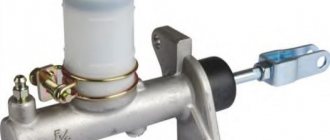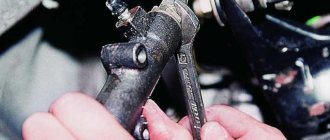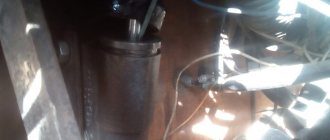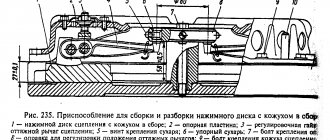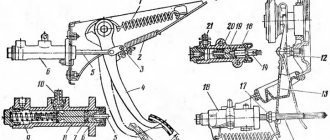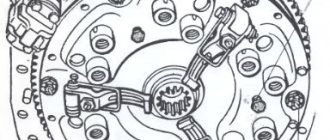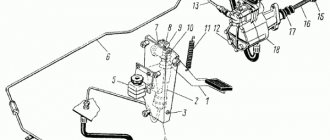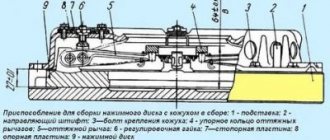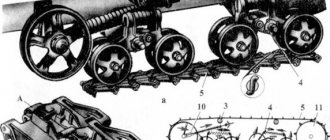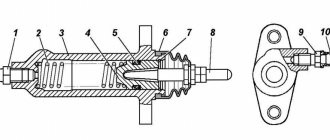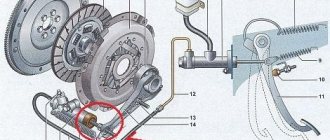In any car, the main unit is the power plant - it ensures the conversion of fuel combustion energy into mechanical energy - rotation of the crankshaft. All the work of the power plant is aimed only at obtaining this rotation.
But getting the rotation is not enough to move the car. There are a lot of conditions for the movement of a car - it needs to start moving, where maximum traction force should be provided, then pick up speed, where traction force is not so important, but a high rotation speed is required, and the car must also change the speed of movement by quickly changing the rotation speed and traction force .
A car engine cannot provide this, since the crankshaft rotation speed is within a certain range and the power plant cannot change the speed and traction force.
Clutch - what is it for?
Therefore, the design of the car includes another important element - the transmission. It is this that ensures the transmission of rotation from the power unit to the drive wheels. At the same time, the gearbox included in the transmission allows you to change the traction force and rotation speed supplied to the drive wheels. A classic manual transmission consists of shafts and gears of different diameters. Meshing certain gears allows you to change the force and speed.
But rotation from the engine is constantly supplied to the transmission. This rotation makes it impossible to disengage some gears and engage others during movement. Therefore, another element is included in the transmission design - the clutch.
The clutch is designed for short-term separation of the power plant and gearbox. As a result of the clutch operation, the box is disconnected from the engine, that is, the rotation of the crankshaft ceases to be applied to the box, which allows you to insert the necessary gears without problems.
On passenger cars with manual transmissions, a single-plate dry clutch has become widespread. This clutch consists of a drive disc placed in a basket, a driven disc, release levers or diaphragm, a release bearing and a drive. All this is covered from above by the clutch housing.
Features of working on automatic transmissions
In conventional automatic transmissions, such a transmission element as the clutch is simply absent. But on robotic and cam “automatic machines” it is provided. By the way, on the latter type of transmission the clutch only works when starting. During movement, this element does not function.
Most automatic transmissions use a wet multi-plate clutch. However, squeezing here occurs not by pressing a specific pedal (which simply isn’t there), but by a servo drive (in other words, an actuator). At the moment, it is customary to distinguish between several types of these devices:
- Electric. This servo drive is a stepper motor. It is controlled by an ECU (electronic control unit).
- Hydraulic. Such an actuator is made in the form of a hydraulic cylinder. It is driven by a special hydraulic distributor.
Robotic gearboxes use two types of clutches. They function intermittently. When the first one is pressed to automatically shift a certain gear, the second one waits for a command to press the next one.
Principle of operation
How the car clutch works
The principle of operation of such a clutch is quite simple: the basket, together with the drive disk, is rigidly fixed to the crankshaft flywheel. The disc itself can move relative to the basket, but it is spring-loaded. The driven disk is placed between the drive disk and the flywheel. This disc is coated with friction linings that significantly increase friction. The hub is located in the center of the driven disk. There is a hole made in it with slots. The hub includes the drive shaft of the transmission, and the spline connection provides a reliable but movable connection - the disk can move along the shaft, but the rotation will be constantly transmitted.
When it is necessary to transfer rotation from the engine to the gearbox, the clutch is released. In this position, the drive disk, due to spring pressure, presses the driven disk towards the flywheel. The presence of friction linings provides significant friction force; the driven disk does not slip relative to the drive disk and flywheel. And since the driven disk is connected to the gearbox shaft by a splined connection, rotation is transmitted.
The pressure plate (in common parlance – the clutch basket) is on the right, and the driven disc is on the left. The pressure plate is bolted to the engine flywheel
To disconnect the gearbox from the engine, the driver presses the clutch pedal. Using a drive, it acts on the release bearing. As it moves, it begins to put pressure on the release levers or diaphragm, as a result of which the drive disk moves inside the basket, overcoming the force of the springs. It stops pressing the driven disk against the flywheel, which causes the transmission of rotation to stop, which makes it possible to change gear at the gearbox.
The clutch also helps you get off to a smooth start. When the pedal is gradually released, the drive disc gradually increases the pressure on the driven disc. With low force, the driven disk begins to rotate, but due to insufficient preload, it slips. As the pedal is released and the driven disk is pressed, it rotates more and more, and slippage decreases.
Video: How the clutch works
To ensure that when you press the pedal and then change gears, when you release the clutch pedal, there are no shock loads during a sharp rotation, the driven disk hub is not rigidly fixed to it. It is connected using damper springs, which even out the resulting torsional vibrations.
Couple-uncouple
Transmission. Part 2. Clutch and quickshifter
Text: Artem 'S1LvER' Terekhov
Any motorcycle must be able to disconnect the crankshaft drive from the rear wheel so that the engine can run when the bike is stationary. Despite this obvious statement, imagine this possibility did not always exist.
Many early motorcycles used direct drive via a belt and pulleys on the crankshaft and rear wheel that could not be separated. This drive really worked, but some problems arose during its operation. For example, to stop at an intersection, you had to turn off the engine. And in this case, it was possible to start the bike only from the pusher, which is clearly not the best starting option. The clutch mechanism was designed to ensure that the running engine is decoupled from driving the rear wheel. The second function, no less important, is the ability to select gear ratios on machines that are equipped with a gearbox. Let's see how this mechanism works. Clutch principle Clutch operation is based on friction. In its simplest form, the clutch consists of two discs, one of which is located on the crankshaft journal, and the second is connected through some drive mechanism (chain, belt, gears) to the rear wheel and is pressed against the first disc. If there is a small gap between the disks, the engine runs while the second disk remains motionless. If you connect the disks to each other, the rotation of the crankshaft due to friction will be transmitted to the second disk, and since it is connected to the rear wheel, it will also rotate. So the power supply from the engine to the wheel can be switched on or off as needed. The vast majority of modern production bikes use a manually operated clutch from a lever located on the handlebars. The exception is scooters that use an automatic centrifugal clutch, the operating mode of which depends on engine speed. Our article will focus specifically on the clutch that is used on motorcycles (unfortunately, the format of the article does not allow us to laugh enough at funny stories about scooter riders who switched to motorcycles and try to “brake” with the clutch). How the clutch works The entire clutch assembly is installed on the input shaft of the gearbox (read about the structure of this device in our article). housing or outer drum is mounted on a bearing and can rotate freely and independently of the shaft. The outer clutch drum is directly connected through the forward gear to the crankshaft (although there are also designs in which the clutch is mounted directly on the crankshaft journal; this arrangement is common on motorcycles made by BMW and Moto Guzzi), so that when the crankshaft rotates, it also rotates. The central part of the clutch, or inner drum (hub), is smaller and is located inside the outer drum. It is installed on the input shaft of the gearbox and is secured against rotation by splines, so that when the inner drum rotates, the input shaft also rotates.
Section of a multi-plate clutch in an oil bath, Yamaha R6 2008
The clutch discs are located in the space between the outer and inner drums. Two types of discs are used: smooth and friction. They are arranged alternately, and the exact number of discs depends on the type of clutch and the machine on which it is used. On the outer circumference of the friction discs there are rectangular splines that are installed in the grooves of the outer clutch drum. On the inner circumference of the smooth discs, teeth are cut, which are installed in the grooves of the inner clutch drum. In the normal position (when the bike is in motion), the friction and smooth plates are held in direct contact by springs acting on a plate called the pressure plate . When the crankshaft and outer clutch drum rotate, due to the friction that occurs between the plates, the inner clutch drum, and therefore the transmission input shaft, also rotates. When the rider squeezes the clutch lever, the cable or hydraulic mechanism, counteracting the force of the springs, pushes the pressure plate away from the pack of smooth and friction plates, causing the discs to no longer touch. By eliminating direct contact between the discs, friction is reduced, allowing the outer drum to rotate freely relative to the inner drum. As the rider releases the clutch lever, the discs are pressed against each other again, and gradually the rotation of the outer clutch drum due to friction begins to be transferred to the inner drum, thus gradually transmitting torque to the gearbox and further to the rear wheel; this eliminates the possibility of stopping or jerking (of course, if you do everything correctly and release the clutch smoothly). The ability of the clutch to transmit torque depends on many factors: the number and diameter of the discs, the force of the springs compressing them, and the coefficient of friction between the discs. All other things being equal, smaller machines require fewer disks than large, powerful machines. Likewise, if the torque is the same, then by increasing the diameter of the disks their number can be reduced. Friction discs (who would have thought?) have friction material applied to them, while smooth discs are made of steel.
2007 Honda CBR1000RR Clutch Components
Design matters When choosing the type of clutch to be installed on a particular motorcycle, several determining factors influence the designer's decision. First, let's look at the number of disks. A multi-plate clutch uses more than one set of smooth and friction discs, usually seven or eight, and sometimes nine friction discs are used. There are always one fewer smooth discs compared to friction discs, since the disc package is always limited on both sides by friction discs. On most monoblock engines (that is, those in which all transmission components are located within the engine crankcase) with a transverse crankshaft in the frame, a multi-plate clutch is used. The reason for this is the small clutch diameter. A multi-disc clutch is also much lighter than a single-disc clutch, although it has a larger friction surface and strength. Single- or double-plate clutches are used on motorcycles with a longitudinal crankshaft in the frame (for example, Moto Guzzi bikes with a V-twin, the cylinders of which are located across the frame). The clutch is mounted on the rear journal of the crankshaft and has a separate housing between the engine and gearbox. Because of this arrangement, the clutch does not need to be compact, and with large diameters only one or two discs are needed. The next question that designers decide is to use a dry clutch or one operating in an oil bath.
Ducati 749 dry clutch on display (covered in stock, of course)
It may seem strange that a mechanism whose principle is based on friction should operate in oil; but there are several important reasons for this. The oil acts as a heat dissipator to prevent the clutch from burning. In addition, it serves as a lubricant for the bushings or bearings on which the outer clutch drum rotates, and also facilitates the movement of splines and disc teeth. An additional “bonus” of an oil bath clutch is that to ensure lubrication of the front gear, you do not need to seal the clutch in a separate chamber. You can’t go against physics - naturally, the friction provided between the clutch discs operating in an oil bath is lower than the friction between the dry clutch discs. Therefore, large-diameter disks or a larger number of them are required (or perhaps both), which leads to increased dimensions.
Suzuki RGV250 equipped with dry clutch
The same RGV250, but with an oil bath clutch
This is why dry clutches are mainly used on sports bikes. High efficiency and low weight (no need to pour oil) are an integral part of a dry clutch. However, the same as a small resource. Most racing machines are equipped with a dry clutch, as are almost all civilian Ducati sportbikes (except for the 848, but there is a separate one for it). Japanese manufacturers mainly use oil bath clutches. From a practical point of view, a “wet” clutch looks preferable - a much longer service life and less tendency to overheat. On the other hand, if the goal is maximum performance in a race, then the choice will be in favor of a dry clutch.
Nothing is broken here, this chirping sound is the sound of a working dry Ducati clutch
Another point that the designer must decide is how the force from the lever will be transmitted to the clutch drive mechanism. Most often, a cable is chosen for this purpose, otherwise a mechanical clutch drive . Cables are subject to stretching and wear, and require adjustment and lubrication, but are easy to maintain and repair. The mechanical drive is simple - the cable acts on the clutch through a drive mechanism located inside the clutch cover or on the opposite side of the crankcase, while the mechanism acts on a long pusher passing through the input shaft of the gearbox. The hydraulic clutch drive mechanism is used mainly on large-volume machines. It costs much more and requires careful maintenance, but the shortcomings are more than offset by the smoothness and ease of its operation. The hydraulic drive operates on the same principle as the front brake system (we will also talk about brake systems in due course): when the lever presses on the master cylinder plunger, it acts on the hydraulic fluid and forces it into the hose. The fluid then pushes the piston of the working cylinder, which acts on a pushrod located inside the input shaft. Other than regularly checking the fluid level, the hydraulic system requires little to no maintenance, although fluid and seals must be replaced periodically to keep it functioning properly. Also, the design of any hydraulic system implies that the fluid is prone to absorbing water and becoming saturated with air (in short, servicing the hydraulic clutch is similar in care to servicing the brake system). With that out of the way, let's move on to more modern and high-tech stuff. I think that while reading reviews of modern motorcycles, you have repeatedly come across the phrase “slipper clutch.” As a rule, the presence of it on the motorcycle being tested delights the tester, which he immediately reports. However, no one really explains how this thing works. Let's start with this. Slippery type The slipper mechanism in the clutch (hereinafter referred to as PS for simplicity) is a development aimed at high-performance motorcycles. The main goal for the PS is to limit the reverse torque that appears when braking the engine from high speed or when changing to lower gears. For the first time, the PS was used on a drag bike of the 70s under the name Hogslayer - a non-trivial clutch for that time allowed the “Pig Killer” to accelerate to 290 km/h without slipping or overheating (in addition, two 880 cc injection engines contributed to this maximum speed from Norton, but that's a completely different story...). Among modern production motorcycles, the slipper clutch has also found its place - mainly, it is equipped with sportbikes, as well as charged factory street bikes.
Slipper clutch for Ducati 999 from FBF
Now let’s take a closer look at why PS is used in general. When the gas is opened, the rear wheel is driven through the clutch. When the throttle is closed and the bike continues to move at a speed higher than the set limit corresponding to the current throttle opening, the rear wheel is still turning the engine shaft through the clutch; but because the engine offers a lot of drag (due to compression, especially at high speeds and lower gears), it is possible to reach a point where the drag, or back-torque, of the engine exceeds the rear tire's coefficient of adhesion. The result of this is a locked rear wheel. This outcome is especially likely in rainy conditions, because... in the rain, the coefficient of adhesion between the tire and the road is greatly reduced, and the weight redistribution that occurs during sudden braking reduces the load on the rear axle. PS is installed in order to eliminate the possibility of wheel locking due to clutch slipping when changing the direction of torque transmission. However, the PS does not disengage the clutch completely, and the engine braking effect remains. Different manufacturers approach the design of the clutch in different ways, but most often slippage is ensured by the following mechanism: the inner clutch drum is located on a series of ratchet stops with an inclined surface. When the direction of torque transmission changes, the inner clutch drum moves on the ratchet stops, thereby retracting the pressure plate and relieving pressure on the discs. This approach was commercially tested for the first time on the Kawasaki ZXR 750.
2007 Kawasaki ZX-6R Slipper Clutch - Standard
Aprilia engineers took a more complex and technological path when designing the RSV Mille clutch. To move the inner clutch drum, a servomotor is used, which is controlled by a vacuum supplied from the engine intake manifold. When the throttle is closed, the increased vacuum in the manifold creates a vacuum in the air line of the servomotor, which shifts the inner clutch drum and relieves pressure on the discs. This approach is no longer used anywhere except RSV; manufacturers prefer a simpler option, tested on the ZXR 750 (each company tries to bring something different to the PS design, but the general principle remains very similar to the Kawasaki version). Whatever one may say, despite its simplicity, the slipping mechanism in the clutch is a very, very useful thing. If your motorcycle is not equipped with PS, do not despair, it is likely that a tuning kit for it exists in nature, you just need to look for it. Quickshifter Finally, we got to the long-awaited topic - the Translogic quickshifter systems, also known as BMW Quickshifter. Contrary to the sensational statements of the German company about the new super technology, such systems of “quick gear shifting without the rider releasing the clutch”, produced by some tuning companies, the most famous of which are Translogic and Dynojet, have long been used by participants in the World Superbike, Supermoto/MX and even go-karts It's just that BMW was the first company to decide to install this system in some production bikes.
The advantage of the mechanism is inherent in its very name: “quick” - “fast”, “shift” - “shift, displacement, switching”. That is, “quickshifter” literally translates as “quick switch”. How quickly do the gears change, you ask? The answer can be found in the example given on the official Translogic page. “The most professional motorcycle racer takes at least 340 milliseconds to change gear, while Translogic systems require 48 to 150 milliseconds.” Impressive, isn't it? Another technology that came down from the Olympus of big-time motorsport and became accessible to “mere mortal” motorcyclists.
DynoJet QuickShifter Kit
Now let’s look at the “quick click” device. The key elements of the entire mechanism: a pressure sensor (monitors the pressure on the gear shift foot; simply put, it determines whether the rider presses it or not) and a quickshifter rod (if the standard one does not fit). Some manufacturers (for example, Dynojet) also offer a quickshifter on/off button that can be mounted on the steering wheel. The sensor is connected to an external ignition control module (for example, Power Commander). When the rider puts pressure on the gear shift paw, the sensor sends a signal to the ignition control module, after which it instructs the ECU to temporarily turn off the ignition (for a few tens of milliseconds). When the engine is turned off, switching occurs - without releasing the gas or squeezing the clutch. In the case of BMW motorcycles, there is no need to buy an ignition control unit - the quickshifter is connected to the original “brains”, nothing needs to be adjusted or installed. Usually a quickshifter is installed when they want to improve the acceleration dynamics of the device, but nothing prevents you from shifting down in the same way when braking.
*****
I hope that by reading this article you have made some further progress in understanding what a motorcycle is. However, a lot of ironclad questions have not yet been solved, so stay tuned, there are many interesting topics for discussion ahead!
Classification
This described the design and operating principle of a single-plate dry clutch. However, there are several types of them, with their own specific characteristics. In general, a whole classification of clutch types has even been introduced.
This classification divides clutches according to the type of drive, the friction used, the number of driven disks, and the mechanism for releasing the driving disk.
There are several types of clutch drive. The very first and simplest drive is mechanical. It uses a system of levers and rods, or the drive can be a cable drive.
There is a hydraulic drive. In such a drive, liquid is used as a working element. The design includes two cylinders - the main one is connected to the clutch pedal, and the worker is connected to the fork, which moves the release bearing.
Some trucks use a pneumatic drive, the working element of which is compressed air. In such a drive, the clutch pedal is connected to a control valve. When the pedal is pressed, the driver opens the valve and air under pressure enters the pneumatic chamber connected to the fork.
There are also combined drives that combine several types of drives described above (for example, a hydromechanical drive).
Classification according to the friction used divides clutches into dry and oil bath. Dry, such as described above, works in an air environment. Many motorcycles use a clutch that is placed in an oil bath.
As for the classification by the number of slave disks, there are single-disk, double-disk and multi-disk. Single-disk is described above. In a double-disk system, two slave disks and two leading disks are used - an intermediate and a leading one. The operating principle is identical to the single-disk one, the only difference is in the number of disks and the trigger mechanism. There are multi-plate clutches that have become widespread on motorcycles.
According to the clutch release mechanism, they are divided into lever and diaphragm. In lever clutches, the drive disc is pressed out using spring-loaded levers, which are acted upon by the release bearing. In a diaphragm clutch, the role of springs and levers is performed by a diaphragm made of springy metal.
Car clutch device
Clutch is a mechanical device that transmits torque from the engine to a manual transmission (manual gearbox) based on sliding friction and is capable of briefly interrupting the transmission of torque from the engine to the manual transmission.
The main elements of the clutch are:
Flywheel. Clutch basket (drive plate or pressure plate).
Clutch disc (driven disc).
Clutch drive parts:
Clutch pedal. The force from pressing the clutch pedal onto the clutch basket can be transmitted in various ways:
— hydraulic drive (there is a clutch master cylinder, a clutch hose or tube, a clutch slave cylinder, a clutch fork, a release bearing). Some cars have a vacuum clutch booster, and sometimes the clutch slave cylinder is combined with the release bearing, but there is no clutch fork.
— a mechanical drive involves the transmission of mechanical force from the pedal to the fork through cables or a system of levers. — pneumatic drive (includes almost the same elements as the hydraulic drive, only the working fluid in the system is not brake fluid, but compressed air). — electromechanical drive (there is a clutch pedal position sensor, an electronic control unit, an actuator (solenoid, electromagnet) for the fork drive). — combined systems (combine elements of several systems).
Classification
By the number of driven discs: - single-disc (the most common type of clutch). — double-disc (used on large trucks, special equipment, sports cars).
— multi-disc (motor vehicles, special equipment).
By control method: - mechanical (used on small cars or very old cars). — hydraulic (the most common option). — pneumatic (used on large trucks and special equipment). — electric (often found on modern cars with a robotic gearbox).
- combined systems.
By type of friction: - dry (the most common type)
— oil (motor vehicles)
Flywheel
The flywheel is a massive metal disk. In the center of the disk there are several circularly located holes intended for attaching the flywheel to the crankshaft. There is a hole in the center of the flywheel for a bearing or flywheel bushing. The free end of the manual transmission input shaft is inserted into this bearing. Along the perimeter of the flywheel there is a gear ring - a crown. The crown is necessary to connect the starter bendix with the crankshaft flywheel.
Clutch basket (drive plate or pressure plate)
There are two main types of clutch basket designs: 1. Clutch baskets with a diaphragm spring 1.1. Direct spin. 1.2. Reverse spin.
2. Spring-lever type clutch baskets
The main elements of baskets with a diaphragm spring are: - Pressure disk (is a massive steel disk, one surface of which is smooth and is intended for contact with the friction lining of the driven clutch disk, and the other surface is uneven and has various protrusions and indentations and is intended for articulation with the basket casing).
Basic faults
The clutch design does not include a significant number of components, which is why it does not break so often. And yet, there are also malfunctions in the clutch.
Video: How to determine basket and flywheel wear
Since the single-plate dry clutch is the most widely used in passenger cars, we will consider the most common malfunctions that occur with it:
- Clutch slipping. Usually this malfunction occurs due to incorrect adjustment of the drive. Due to the compression of the release bearing, it does not allow the drive disk to fully press the driven disk against the flywheel, resulting in slippage. This malfunction is accompanied by a characteristic smell of burnt clutches in the cabin and difficulty shifting gears. Severe wear of the clutches, or their damage, can also be accompanied by such symptoms;
- The clutch "drives". This problem also occurs due to incorrect adjustment. In this case, the release bearing is not able to fully depress the drive disc due to the increased gap between the bearing and the fork. A sure sign that the clutch is “driving” is the car continuing to move after a complete stop and squeezing the clutch with 1st gear engaged;
- Noise coming from the clutch housing. Increased noise in this unit can only be created by one element - the release bearing. It can make noise either as a result of slipping, or due to excessive wear;
There are other malfunctions, but they are much less common than those described above. Thus, problems with the clutch can arise due to destruction of the diaphragm or springs of the release levers, significant wear of the damper springs, etc.
Finally, I would like to note that the clutch does not require particularly complex maintenance. It is enough to periodically adjust the free play of the drive, as well as follow the recommendations for careful driving.
Switching from direct to reverse squeeze
Hi all. I have a 5 speed gearbox with direct release. I want to install a clutch from a 6 speed speed. people bet, but with the opposite of the opposite. I got a good set, I want to stick it in and try it, they say it holds better. Someone has given some idea of the scope of work, what is needed, maybe there are some diagrams, I will be glad for any help!
someone already wanted to get confused, saw the topic, rummaged around in the search
Did you get the WHAT kit? Clutches? With a flywheel? Then the gearbox needs to be changed under reverse pressure. And she has to cut the bell for a 6-speed clutch. And change the internal CV joints. And this is how everything is done.
Yes, the couplings and the bell were cut. But why the scars? As I understand it, there is a difference in the fork and its operation, or am I wrong?
The design of the box includes what the squeeze will be. If you have a gearbox for forward release, then you will not install the clutch for reverse release. This means replacing the gearbox. And all reverse gearboxes usually come with splines sticking out of the box. An inner CV joint is put on them and secured with a cotter pin. Is it like this for you?
It seems that not everything, I have a gearbox here, a reverse release, the drives are inserted into the gearbox.
I don't know, I got a clutch from the 6th speed. They sawed the bell under it and then it turned out that it has a reverse release, but the box is straight. I heard that gikens are sold with a reverse one and they come with brackets for installation on a straight box. So that it can move more, since it is stronger.
Doesn't anyone know or hasn't done it?
there the clutch cylinder is in the other direction. I think it’s different in itself. different hose. ebbs on the bell for mounting the cylinder in a different place. in the gearbox there is an axle for the fork, the fork is accordingly different. If possible, look at the gearbox with a bell under reverse pressure and you will understand the difference and the inappropriateness of the alteration.
Source
Direct or reverse clutch release subaru
Post by daniil_spb » 18 Nov 2013, 22:14
The assembly (disc, basket, release) and new flywheel... everything is new... on the same car as mine (GH8 body) the same clutch kit and everything is fine, nothing slips. damn weird!
Re: NEW clutch slips! I need help, advice.
Message by “Alexey” » November 18, 2013, 10:20 pm
Re: NEW clutch slips! I need help, advice.
Post by daniil_spb » 18 Nov 2013, 22:26
at the very top..as if it ends..
Re: NEW clutch slips! I need help, advice.
Message by “Alexey” » November 18, 2013, 10:33 pm
Re: NEW clutch slips! I need help, advice.
Post by daniil_spb » 18 Nov 2013, 22:35
Direct squeeze, 5 speed...due to the rod the clutch can slip. what exactly should you pay attention to? [/size] [/color][/align]
Re: NEW clutch slips! I need help, advice.
Message by “Alexey” » November 18, 2013, 10:39 pm
Re: NEW clutch slips! I need help, advice.
Post by daniil_spb » 18 Nov 2013, 22:47
alexmi wrote: Maybe because of the stock. It doesn’t seem to have much adjustment, the hydraulics can open the cuffs.
thanks, we'll look at the stock tomorrow..
Re: NEW clutch slips! I need help, advice.
Posted by thedeath » 19 Nov 2013, 03:24
) so they told me - look at the hydraulics. I looked at and changed everything from the pedal assembly, hydraulics, etc. for about one hundred kilometers. to the box and external inspection of the interior.
It turned out that “qualified specialists” supplied me with a disk of a smaller diameter (by the way, according to the catalogue, it almost beat ;)). Upon external inspection, all this stuff looked new and generally serviceable. But when driving more than 4 revolutions, the clutch stank, and when driving for a long time, it also began to pound when starting off.
In short, double-check the parameters of the hardware you stuffed in. What kind of ceramics and what kind of flywheel are there, any specs/links?
Re: NEW clutch slips! I need help, advice.
Post by Donorparts » 19 Nov 2013, 07:56
Clutch - direct or reverse. ⇐ Boxer 1, 2. Transmission
Post by Andrey Sh » 15 Sep 2009, 17:57
Message from Andryukha from St. Petersburg » 15 Sep 2009, 18:12
Post by Andrey Sh » 15 Sep 2009, 19:47
Post by Mishanius » Sep 15, 2009, 8:47 pm
Post by Andrey Sh » 16 Sep 2009, 09:36
Post by medwwed » Jul 01, 2011, 12:43 pm
Post by romatrush » 03 Jul 2011, 09:02
The reverse squeeze was set to 2.8. The regular 2.5 D has a regular clutch. A set of BOW in Minsk costs no more than 150 USD. The same can’t be said about the reverse squeeze; everyone recommends installing only Valeo there, costing about $300. Yes, and installing such a kit is a whole epic. So replacing the clutch with reverse release will cost 500-600 dollars, and with normal release it will cost 250-300. The lifespan of both is affected by the gasket between the steering wheel and the seat :) (I drove 180,000 km on the Jumper 2.5 TD and I didn’t know what a clutch was, I only adjusted it once using a ruler.)
Reverse squeeze.
Good day! I’m assembling a car and now I have a question about the clutch with what pressure to use. Direct or reverse? It’s all natural, two-disc ceramic! Have you heard that with reverse the release lever often flies out!?
Are direct and reverse squeeze interchangeable?
There are couplings for sale and there are some kits, as I understand it, included for direct!
It's a reverse squeeze, I mean 6-speed manual transmission. I won’t say anything about 2-disc ceramics.
I have a 6-speed manual transmission in reverse, I would like to know if, for example, a 30.35 gearbox is installed, will the release lever fly out? It’s just that one friend, after he assembled the car with a reverse release (double-disc ceramic), the release lever flew if you shifted hard!
I think it's just a crooked clutch. And in a straight line I can’t imagine how to change it, the cylinder should be on the other side, it’s unlikely that it fits in the kit
You are mistaken, the direct release is easy, but you need to replace the working clutch (it fits on standard mounts), the basket, and the flywheel. That's the whole package.
